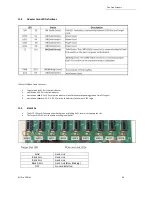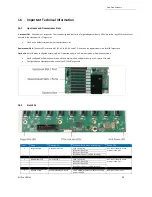
One Stop Systems
4U Pro 16 Slot
40
13
Verify HIB Device
This sections contains information on how to check / verify the OSS devices on Linux and Windows OS environments.
13.1
Linux OS
To check if the OSS HIB cards and backplane are detected, use the following commands on the terminal window. You must logged-
in as “super
user (or as root)” when running the lspci command.
•
#lspci
–
tv | grep c010.
The c010 is the Device number of the OSS hardware.
The output below gives you a tree-like structure of the PCI Device B/D/F numbers of b8:00.0 and bd:00.00 (B=Bus number. D=Device number.
F=Function number).
The /B/D/F numbers will vary from system to system
.
When the OSS HIB cards and backplane are detected, you should see three instances of devices enumerated, see photo below.
* If you are only seeing one device, the host card is not linking up with the target device.
* If there are two devices detected, it is an indication that the backplane is not recognized.
You can also run lspci
–
m | g
rep ‘Device 00b2’
.
Three instances of 00b2 signify that both host & targets cards including the
backplane are correctly detected.
If one instance of 00b2 is showing up, only the Host card is detected, the Target and backplane are not recognized.
All PCIe cards in the backplane will not be enumerated.
Photo below shows three instances of 00b2 device, it indicates that the host card, target card and the backplane are recognized.
If only two instances of 00b2 are coming up, both Host and Target cards are detected but the backplane is not recognized.
•
All of PCIe cards installed in the card slots of the backplane will not be enumerated.






























